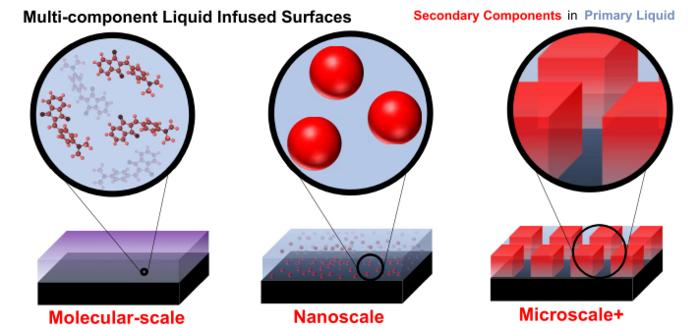Reviewed by Lexie CornerMar 7 2024
Surface coatings, which provide both protection and functionality, have long been important in a variety of industries. Liquid-infused surfaces (LIS) have been a ground-breaking technology that has changed the way of thinking about surface coatings in recent years.

Adding a secondary component to a liquid coating results in new and synergistic properties. Image Credit: Caitlin Howell, University of Maine, United States of America
Authors Zachary Applebee and Dr. Caitlin Howell examine a novel approach in surface technology that could significantly impact various industries, including healthcare and environmental conservation, in a review article published in Industrial Chemistry & Materials on February 23rd, 2024.
Multi-component liquid-infused systems (LISs) with multiple components in the liquid represent a new frontier in liquid science. As a sophisticated development over the single-component liquid coatings that have dominated the field since their inception in the early 2010s, the research presents the idea of multi-component liquid-infused surfaces.
These cutting-edge multi-component surface coatings are intended to be dynamic and able to actively react to their surroundings by combining various components into the liquid layer. This adaptability opens up a wide range of applications, including sophisticated carbon-capture systems, magnetic field-controlled chemical delivery mechanisms, and medical devices that actively and passively fight infection.
In this review, we explore the untapped potential of multi-component liquid-infused surfaces, and by integrating various elements into the liquid coating, we can achieve synergistic effects that enhance functionality in ways previously thought impossible. This opens up new avenues for innovation in both industry and medicine.
Zach Applebee, Graduate Researcher, University of Maine
The study classifies these surfaces according to the molecular to microscale sizes of their secondary components and shows examples of how adding more components can result in novel developments. In addition to showcasing the variety of fabrication techniques, the review lays the groundwork for potential future research avenues in this exciting area.
The most important message in our review is that the liquid nature of liquid-infused coatings is a game-changer in creating surfaces that adapt and respond, and by leveraging the natural processes of liquids, such as diffusion, flow, and return to equilibrium, we can begin to design systems that dynamically move or place secondary materials, whether molecules, nanoparticles, or even other immiscible liquids, exactly where we want, when we want. The possibilities are endless.
Dr. Caitlin Howell, Professor, University of Maine
The researchers are optimistic about the future of this technology. They think that when more engineers and scientists learn about the potential of multi-component liquid-infused surfaces, a wave of innovation will occur, resulting in the creation of systems and materials that have the potential to greatly enhance human well-being and tackle some of the most critical global issues.
Howell concluded, “We believe that multi-component liquid-infused surfaces are well positioned to begin to address a wide range of problems once more researchers become aware of them and could be instrumental in designing new highly targeted drug-delivery systems or creating industrial surfaces that can adapt to different types of foulants in real-time.”
Journal Reference:
Applebee, Z., et al. (2024) Multi-Component Liquid-Infused Systems: A New Approach to Functional Coatings. Industrial Chemistry and Materials. doi:10.1039/d4im00003j